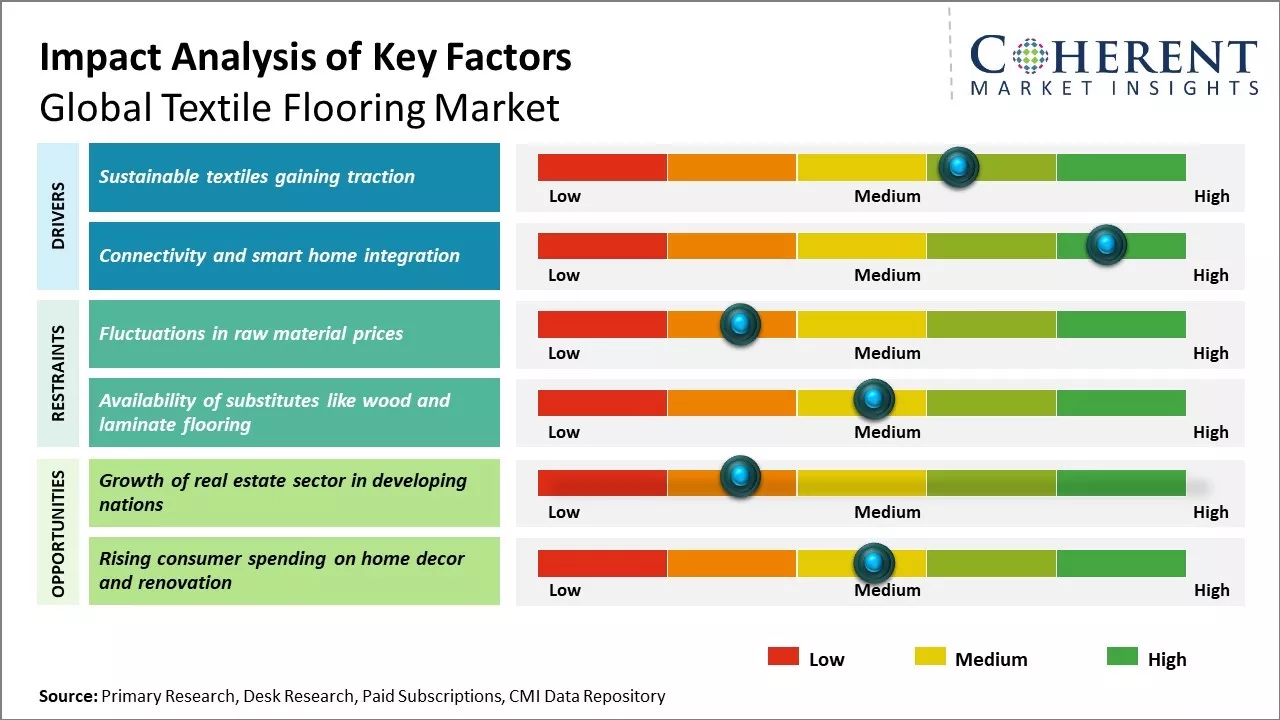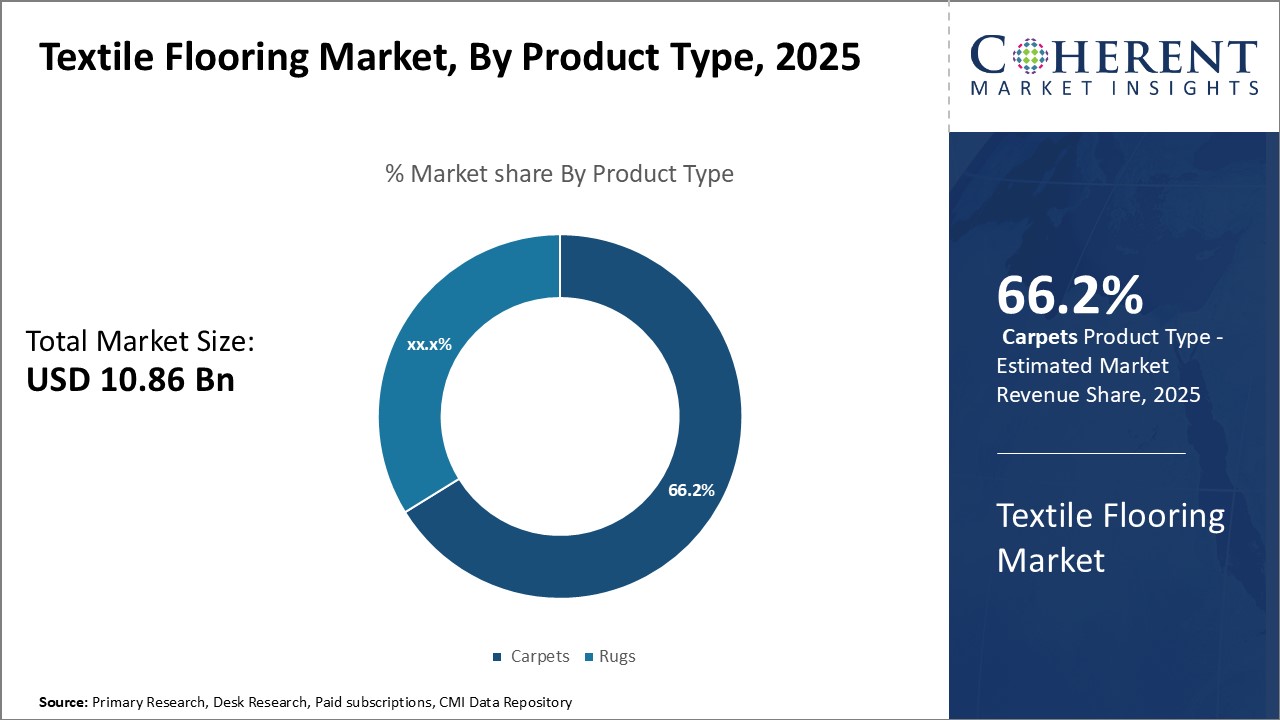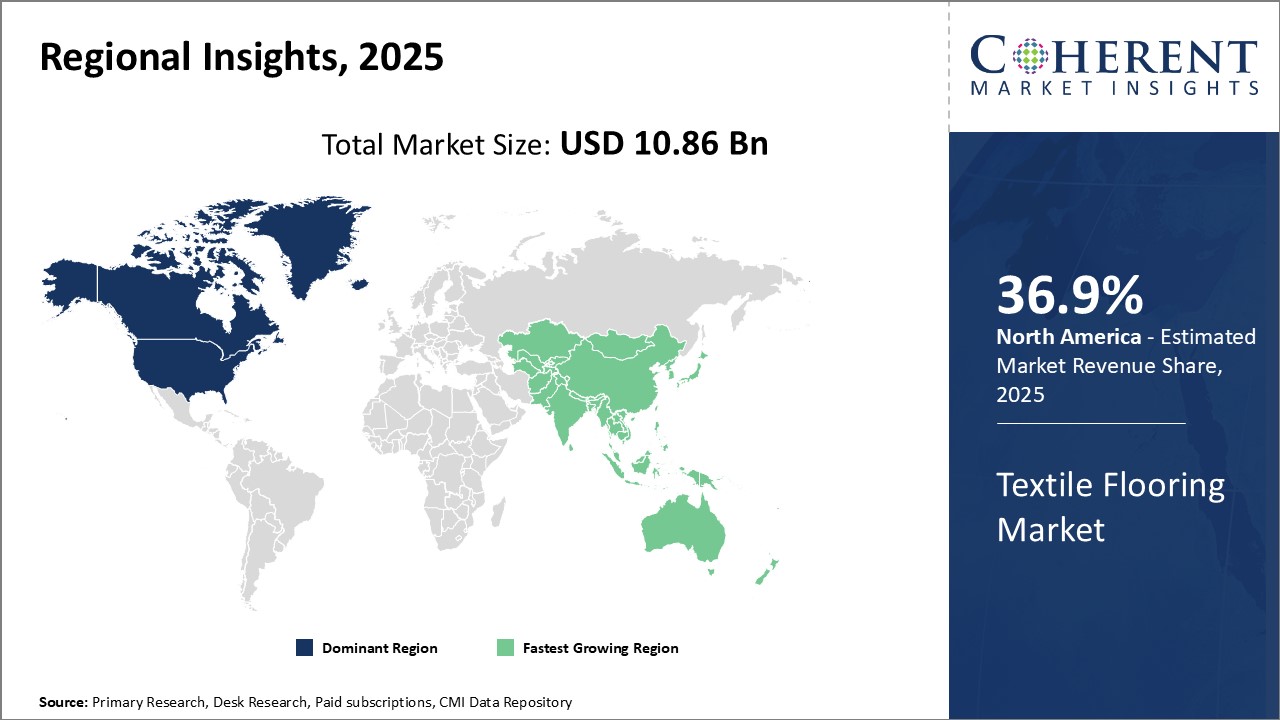The textile flooring market is estimated to be valued at USD 10.86 Bn in 2025 and is expected to reach USD 16.23 Bn by 2032, growing at a compound annual growth rate (CAGR) of 5.9% from 2025 to 2032.

Discover market dynamics shaping the industry: Download Free Sample
Textile flooring provides benefits like durability, flexibility, and acoustics. Its increasing popularity can be attributed to a surge in the demand for sustainable and eco-friendly flooring options across the residential and commercial sectors. The textile flooring market is expected to witness significant growth over the forecast period. Rising consumer demand for resilient, natural, and eco-friendly flooring alternatives is estimated to drive the market growth. Furthermore, growth in construction and renovation activities along with increasing popularity of modular carpets are expected to provide impetus to the textile flooring market.
Sustainable textiles gaining traction
As environmental concerns are at the forefront of consumer minds today, many are seeking sustainable options when it comes to furniture, flooring, and other household goods. Textile flooring manufacturers have taken note of this growing demand and are increasingly offering Flooring made from naturally durable and eco-friendly materials. Some examples include floor coverings woven from organic cotton, coconut or bamboo fibers. These natural materials require less irrigation and chemicals to grow compared to conventional cotton crops. The production process also tends to produce fewer greenhouse gas emissions. Consumers are also attracted to textiles that will last for many years without wearing out, therefore reducing the need for frequent replacement and new materials. For instance, silk carpets can withstand decades of foot traffic due to the strength and flexibility of the fibers. Wool is another durable option and the materials are renewable as wool can be shorn repeatedly from livestock. Both silk and wool carpet flooring allow owners to make a one-time investment that will serve them for a long time. This decreases the lifetime environmental impact compared to quicker-wearing synthetic materials. The sustainability credentials of natural textile flooring appeal to shoppers who want environment-friendly home accents that are made to stand the test of time. As such, this driver indicates the textile flooring market is likely to see considerable growth.

Get actionable strategies to beat competition: Download Free Sample
Connectivity and smart home integrationModern households are increasingly centered around connectivity and control of smart devices. As flooring itself transforms to integrate these capabilities, it is driving growth within the textile flooring market. For instance, some manufacturers are developing carpets woven with fine copper fibers or lined with conductive material. This enables the flooring to function as a sensing mat or giant touchpad within the home. For example, such smart carpets can detect footsteps, falls, moisture levels, or recognize specific patterns of movement. The collected data is then transmitted wirelessly to be integrated with smart home hubs, security systems, or healthcare monitoring devices. Additionally, certain textile floors are outfitted with trace heating elements, LED lights or small speakers. This allows the flooring to take on multi-functional roles such as under-floor heating, ambient lighting, or as a delivery method for music, alerts or messages throughout the home. Connected textile floors offer novel ways for homeowners to interact with their living spaces for added convenience, safety, or entertainment.
Key Takeaways of Analyst:
The textile flooring market has significant opportunities for growth in the coming years. Several macroeconomic factors will positively influence demand. Rising income levels in developing economies are allowing more consumers to opt for textile flooring over conventional materials due to its aesthetic and acoustic benefits. Further, the booming real estate and construction industry is necessitating more floor space that can be economically furnished using textile flooring such as carpets and rugs.
Introduction of innovative production technologies is enabling manufacturers to offer a wider variety of design-led and customized flooring solutions. This is appealing to customers and boosting brand loyalty. Additionally, growth of online retail is facilitating easier access to a diverse range of textile flooring products for consumers.
Volatility in raw material prices remains a challenge for flooring producers. Fluctuations in crude oil can impact resin and polypropylene costs which are important inputs. Also, the market sees strong competition among established players globally. This may restrict the ability to significantly hike prices even during a commodity cycle upturn. Furthermore, stringent environmental regulations around synthetic materials used in flooring production are a restraint.
Challenges: Fluctuations in raw material prices
Fluctuations in the prices of raw materials have posed significant challenges to the growth of the global textile flooring market in recent years. Raw materials such as natural and synthetic fibers, resins, pigments, and dyes that are used extensively in manufacturing carpets and rugs have witnessed steep price volatility due to various economic and geopolitical factors. For instance, oil prices, which determine the pricing of raw petrochemicals that serve as feedstock for producing synthetic fibers like nylon, polyester etc., have fluctuated widely in the past five years
Opportunities: Growth of real estate sector in developing nations
The rapid growth and urbanization in many developing nations presents a huge opportunity for the global textile flooring market. As more people migrate to cities in search of better living standards and job opportunities, the demand for residential and commercial real estate is surging enormously. According to United Nations data, urban populations in Africa and Asia are projected to grow by more than 3 billion people by 2050. This exponential rise in urban dwellers will necessitate massive construction of housing, malls, offices and other infrastructure where textile flooring plays a key role.

Discover high revenue pocket segments and roadmap to it: Download Free Sample
Insights by Product Type: Comfort and Durability Drive the Carpet DemandIn terms of product type, carpets is expected to contribute 66.2% share of the market in 2025, owing to its ability to provide comfort and withstand foot traffic over long periods of time. Carpets offer a soft surface underfoot that makes them ideal for bedrooms and living rooms where people spend a good portion of their day relaxing or entertaining guests. Their plush texture muffles sound for a tranquil environment and protects flooring underneath from damage caused by day-to-day activities. Various carpet materials like nylon, polyester, and polypropylene are manufactured to last for many years with regular vacuuming and occasional professional cleaning. Some advanced carpet technologies employ moisture-wicking fibers that keep floors feeling dry underfoot. Stain-resistant coatings on carpet fibers help protect against spills and make them easier to maintain for busier households. As such, carpets provide an affordable option for flooring that can enhance comfort, aesthetics, and value in the home over time relative to its initial cost.
Insights by Technology: Efficiency Drives the Demand for Tufting Technology
In terms of technology, tufting is expected to contribute 43% share of the market in 2025, due to its ability to produce carpets at high speeds on an industrial scale. The tufting process utilizes specialized sewing head machinery to drive yarn loops into a backing material to create patterned pile surfaces. Compared to other carpet manufacturing methods, tufting offers unprecedented efficiency that allows for mass production runs. Tufting equipment can punch hundreds or even thousands of loops per minute depending on the head configuration and type of carpet being made. This rapid output enables economies of scale where high volume helps reduce costs. As a result, tufting technology lends itself well to producing standard carpet designs at competitive price-points. It also facilitates quick color and style changes during production for made-to-order runs. The ability of tufting lines to quickly adjust to market demands and minimize downtime between product batches gives this method an advantage over others in terms of cost efficiency and flexibility.
Insights by Material Type: Synthetic Textiles' Durability Powers their Popularity
In terms of material type, synthetic textiles are expected to contribute 37.2% share of the market in 2025, due to their hardwearing performance well-suited for high-traffic applications. Made from durable fibers like nylon, polyester, and polypropylene, synthetic carpets are engineered to withstand extensive foot traffic and tolerate frequent vacuuming and cleaning. These man-made materials resist matting and crushing better than natural fibers to maintain a luxurious aesthetic over longer periods of use. Their synthetic composition also enables the use of advanced finishing treatments that boost stain, soil, moisture, and fade resistance without compromise. Carpets constructed of synthetic textiles maintain their integrity indoors where conditions are controlled compared to seasonal fluctuations that more readily damage natural materials. As carpets see heavy 360-degree use covering floors, their need to tolerate repetitive press and wear makes synthetics among the best performing options. When factoring in a material's ability to retain quality aesthetic and physical properties under demanding conditions, synthetic textiles prove themselves as a reliable and cost-effective choice.

Need a Different Region or Segment? Download Free Sample
North America has dominated the global textile flooring market for many decades. The region is expected to account for 36.9% of the market share in 2025. The U.S., in particular, has a strong industrial base and well-established distribution channels for textile flooring products. Major fiber producers, material manufacturers, and flooring brands have their headquarters in the region, allowing them to leverage economies of scale and tight supply chain management. This helps them offer a wide variety of cost-effective and high-quality textile flooring options to consumers across commercial and residential sectors. In addition, growing awareness about environmentally-friendly flooring alternatives and substantial spending on interior design and renovation has further aided market growth over the years. However, rising labor costs and intense competitive pressures could impact future expansion across the U.S. and Canada.
The Asia Pacific region has emerged as the fastest growing market for textile flooring worldwide in recent times. China leads the pack due to strong exports of tufted and woven flooring products. It accounts for over half of global textile flooring manufacturing and acts as a key sourcing hub for many international brands as well. Additionally, several Indian and Southeast Asian companies have invested in setting up cutting-edge production facilities. They are swiftly expanding their operations to capture the growing demand from price-sensitive consumers as well as replace European imports in new residential construction projects. Continued economic prosperity, rapid urbanization, rising incomes, and consistent double-digit growth of its real estate sector provide tailwinds to the Asia Pacific textile flooring market. However, currency fluctuations and changing trade policies could dent its export competitiveness going ahead.
Textile Flooring Market Report Coverage
| Report Coverage | Details | ||
|---|---|---|---|
| Base Year: | 2024 | Market Size in 2025: | USD 10.86 Bn |
| Historical Data for: | 2020 To 2024 | Forecast Period: | 2025 To 2032 |
| Forecast Period 2025 to 2032 CAGR: | 5.9% | 2032 Value Projection: | USD 16.23 Bn |
| Geographies covered: |
|
||
| Segments covered: |
|
||
| Companies covered: |
Mohawk Industries, Inc., Interface, Inc., Beaulieu International Group N.V, Tarkett SA, Balta Group, Shaw Industries Group Inc., Forbo Holding AG, Mannington Mills, Inc., J+J Flooring Group, Vorwerk and Co. KG., Welspun Living, RELSO, Natroyal Group, Saif Home Pvt Ltd., Marwar Carpets, and Javi Home |
||
| Growth Drivers: |
|
||
| Restraints & Challenges: |
|
||
Uncover macros and micros vetted on 75+ parameters: Get instant access to report
*Definition: The textile flooring market includes products made from natural and synthetic materials that are used as floor coverings. Textile flooring includes carpets, rugs, mats, and other coverings made from materials such as wool, nylon, polyester, polypropylene, and cotton. These textile floor coverings are designed to provide aesthetic appeal, comfort, insulation, and easy maintenance benefits for residential, commercial, and institutional applications.
Share
Share
About Author
Yash Doshi is a Senior Management Consultant. He has 12+ years of experience in conducting research and handling consulting projects across verticals in APAC, EMEA, and the Americas.
He brings strong acumen in helping chemical companies navigate complex challenges and identify growth opportunities. He has deep expertise across the chemicals value chain, including commodity, specialty and fine chemicals, plastics and polymers, and petrochemicals. Yash is a sought-after speaker at industry conferences and contributes to various publications on topics related commodity, specialty and fine chemicals, plastics and polymers, and petrochemicals.
Missing comfort of reading report in your local language? Find your preferred language :
Transform your Strategy with Exclusive Trending Reports :
Frequently Asked Questions
Joining thousands of companies around the world committed to making the Excellent Business Solutions.
View All Our Clients